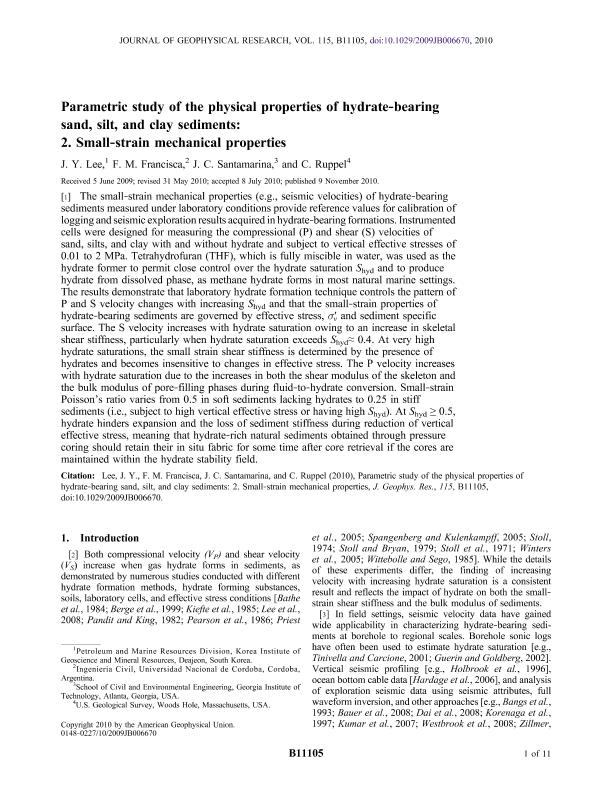Mostrar el registro sencillo del ítem
dc.contributor.author
Lee, Joo Yong
dc.contributor.author
Francisca, Franco Matias

dc.contributor.author
Santamarina, Juan Carlos
dc.contributor.author
Ruppel, Carolyn
dc.date.available
2023-02-17T19:13:28Z
dc.date.issued
2010-11-09
dc.identifier.citation
Lee, Joo Yong; Francisca, Franco Matias; Santamarina, Juan Carlos; Ruppel, Carolyn; Parametric study of the physical properties of hydrate-bearing sand, silt, and clay sediments: 2. Small-strain mechanical properties; American Geophysical Union; Journal of Geophysical Research: Solid Earth; 115; B11; 9-11-2010; 1-11
dc.identifier.issn
2169-9356
dc.identifier.uri
http://hdl.handle.net/11336/188474
dc.description.abstract
The small‐strain mechanical properties (e.g., seismic velocities) of hydrate‐bearing sediments measured under laboratory conditions provide reference values for calibration of logging and seismic exploration results acquired in hydrate‐bearing formations. Instrumented cells were designed for measuring the compressional (P) and shear (S) velocities of sand, silts, and clay with and without hydrate and subject to vertical effective stresses of 0.01 to 2 MPa. Tetrahydrofuran (THF), which is fully miscible in water, was used as the hydrate former to permit close control over the hydrate saturation Shyd and to produce hydrate from dissolved phase, as methane hydrate forms in most natural marine settings. The results demonstrate that laboratory hydrate formation technique controls the pattern of P and S velocity changes with increasing Shyd and that the small‐strain properties of hydrate‐bearing sediments are governed by effective stress, s′ v and sediment specific surface. The S velocity increases with hydrate saturation owing to an increase in skeletal shear stiffness, particularly when hydrate saturation exceeds Shyd≈ 0.4. At very high hydrate saturations, the small strain shear stiffness is determined by the presence of hydrates and becomes insensitive to changes in effective stress. The P velocity increases with hydrate saturation due to the increases in both the shear modulus of the skeleton and the bulk modulus of pore‐filling phases during fluid‐to‐hydrate conversion. Small‐strain Poisson’s ratio varies from 0.5 in soft sediments lacking hydrates to 0.25 in stiff sediments (i.e., subject to high vertical effective stress or having high Shyd). At Shyd ≥ 0.5, hydrate hinders expansion and the loss of sediment stiffness during reduction of vertical effective stress, meaning that hydrate‐rich natural sediments obtained through pressure coring should retain their in situ fabric for some time after core retrieval if the cores are maintained within the hydrate stability field.
dc.format
application/pdf
dc.language.iso
eng
dc.publisher
American Geophysical Union

dc.rights
info:eu-repo/semantics/openAccess
dc.rights.uri
https://creativecommons.org/licenses/by-nc-sa/2.5/ar/
dc.subject
HYDRATES
dc.subject
SHEAR WAVE VELOCITY
dc.subject
SOIL MODULUS
dc.subject
CHARACTERIZATION
dc.subject.classification
Geología

dc.subject.classification
Ciencias de la Tierra y relacionadas con el Medio Ambiente

dc.subject.classification
CIENCIAS NATURALES Y EXACTAS

dc.title
Parametric study of the physical properties of hydrate-bearing sand, silt, and clay sediments: 2. Small-strain mechanical properties
dc.type
info:eu-repo/semantics/article
dc.type
info:ar-repo/semantics/artículo
dc.type
info:eu-repo/semantics/publishedVersion
dc.date.updated
2023-02-15T09:55:48Z
dc.identifier.eissn
2169-9313
dc.journal.volume
115
dc.journal.number
B11
dc.journal.pagination
1-11
dc.journal.pais
Estados Unidos

dc.journal.ciudad
Washington
dc.description.fil
Fil: Lee, Joo Yong. Korea Institute of Geoscience and Mineral Resources; Corea del Sur
dc.description.fil
Fil: Francisca, Franco Matias. Consejo Nacional de Investigaciones Científicas y Técnicas. Centro Científico Tecnológico Conicet - Córdoba. Instituto de Estudios Avanzados en Ingeniería y Tecnología. Universidad Nacional de Córdoba. Facultad de Ciencias Exactas Físicas y Naturales. Instituto de Estudios Avanzados en Ingeniería y Tecnología; Argentina
dc.description.fil
Fil: Santamarina, Juan Carlos. Instituto Tecnológico de Georgia; Estados Unidos
dc.description.fil
Fil: Ruppel, Carolyn. United States Geological Survey; Estados Unidos
dc.journal.title
Journal of Geophysical Research: Solid Earth

dc.relation.alternativeid
info:eu-repo/semantics/altIdentifier/url/https://agupubs.onlinelibrary.wiley.com/doi/full/10.1029/2009JB006670
dc.relation.alternativeid
info:eu-repo/semantics/altIdentifier/doi/http://dx.doi.org/10.1029/2009JB006670
Archivos asociados
